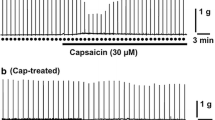Abstract
The muscles of the pharynx are controlled by networks of neurons under the control of specific regions in the brain stem, which have been fairly well studied. However, the transmission between these neurons and the pharyngeal muscles, at the motor end plates, is less well understood. Therefore, an in vitro model for the study of neuromuscular transmission in the pharyngeal muscle of the mouse was developed. Ring preparations from the inferior constrictor and the cricopharyngeus muscles were isolated and mounted for isometric force recording at physiologic temperature. Preparations from the diaphragm and the soleus muscles were examined in parallel. The muscles were stimulated at supramaximal voltage with short tetani at 100 Hz. Following direct stimulation of the muscle fibers, using a longer pulse duration, the rate of force development of the pharyngeal muscles was similar to that of the diaphragm and faster than that of the soleus muscle. By varying the duration of the stimulation pulses, conditions where the nerve-mediated activation contributed to a major extent of the contractile responses were identified. Gallamine completely inhibited the nerve-mediated responses. In separate experiments the dose dependence of gallamine inhibition was examined, showing similar sensitivity in the inferior pharyngeal constrictor compared to the diaphragm and soleus muscles. We conclude that reproducible contractile responses with an identifiable nerve-induced component can be obtained from the mouse inferior pharyngeal constrictor. The pharyngeal muscles have contractile characteristics similar to those of the faster diaphragm. The sensitivity to the neuromuscular blocking agent gallamine of the inferior pharyngeal constrictor was in the same concentration range as that of the diaphragm and soleus muscles.



Similar content being viewed by others
References
Miller AJ, Sensory systems: peripheral and central connections. In: The neuroscientific principles of swallowing and dysphagia. San Diego: Singular Publishing Group; 1999, chap 3. p. 35–72.
Miller AJ, Motor systems. In: The neuroscientific principles of swallowing and dysphagia. San Diego: Singular Publishing Group; 1999, chap 4. p. 73–91.
Bonington A, Whitmore I, Mahon M. A histological and histochemical study of the cricopharyngeus muscle in the guinea-pig. J Anat. 1987;153:151–61.
Dutta CR, Basmajian JV. Gross and histological structure of the pharyngeal constrictors in the rabbit. Anat Record. 1960;137:127–34.
Hyodo M, Aibara R, Kawakita S, Yumoto E. Histochemical study of the canine inferior pharyngeal constrictor muscle: implications for its function. Acta Otolaryngol. 1998;118:272–9.
Mu L, Sanders I. Muscle fiber-type distribution pattern in the human cricopharyngeus muscle. Dysphagia. 2002;17:87–96.
Malmberg L, Ekberg O, Ekström J. Effects of drugs and electrical field stimulation in isolated muscle strips from rabbit pharyngoesophageal segment. Dysphagia. 1991;6:203–8.
Uddman R, Ekberg O, Malmberg L, Borgström P, Fernström G, Ekström J, et al. Neuropeptide-containing nerve fibres in the pharynx of the rabbit. Dysphagia. 1990;4:220–6.
Sundman E. Pharyngeal function, airway protection and anesthetic agents. Thesis, Stockholm; 2002.
Musich J, Walts LF. Pulmonary aspiration after a priming dose of vecuronium. Anesthesiology. 1986;64:517–9.
Uyama E, Hino H, Araki K, Takeya M, Uchino M, Yamamura K. Animal model of oculopharyngeal muscular dystrophy. Acta Myol. 2005;24:84–8.
Davies JE, Wang L, Garcia-Oroz L, Cook LJ, Vacher C, O’Donovan DG, et al. Doxycycline attenuates and delays toxicity of the oculopharyngeal muscular dystrophy mutation in transgenic mice. Nat Med. 2005;6:672–7.
Birmingham AT, Hussain SZ. A comparison of the skeletal neuromuscular and autonomic ganglion-blocking potencies of five non-depolarizing relaxants. Br J Pharmacol. 1980;70:501–6.
Anttila P, Ertama P. Relative potency of some neuromuscular blocking drugs in vivo and in vitro. Med Biol. 1978;56:152–5.
Eriksson LI, Sundman E, Olsson R, Nilsson L, Witt H, Ekberg O, et al. Functional assessment of the pharynx at rest and during swallowing in partially paralyzed humans. Simultaneous videomanometry and mechanomyography of awake human volunteers. Anaesthesiology. 1997;87:1035–42.
Sundman E, Witt H, Olsson R, Ekberg O, Kuylenstierna R, Eriksson LI. The incidence and mechanisms of pharyngeal and upper oesophageal dysfunction in partially paralyzed humans: pharyngeal videoradiography and simultaneous manometry after atracurium. Anesthesiology. 2000;92:977–84.
Kurihara LJ, Kikuchi T, Wada K, Tilghman SM. Loss of Uch-L1 and Uch-L3 leads to neurodegeneration, posterior paralysis and dysphagia. Hum Mol Genet. 2001;10:1963–70.
Freed ML, Freed L, Chatburn RL, Christian M. Electrical stimulation for swallowing disorders caused by stroke. Respir Care. 2001;46:466–74.
Leelamanit V, Limsakul C, Geater A. Synchronized electrical stimulation in treating pharyngeal dysphagia. Laryngoscope. 2002;112:2204–10.
Fraser C, Power M, Hamdy S, Rothwell J, Hobday D, Hollander I, et al. Driving placticity in human adult motor cortex is associated with improved motor function after brain injury. Neuron. 2002;34:831–40.
Burnett TA, Mann EA, Cornell SA, Ludlow CL. Laryngeal elevation achieved by neuromuscular stimulation at rest. J Appl Physiol. 2003;94:128–34.
Acknowledgment
The study was supported by grants from the Swedish Research Council (2003-5788, 2006-4604) and by the Lund School of Pharmaceutical Research.
Author information
Authors and Affiliations
Corresponding author
Rights and permissions
About this article
Cite this article
Ekberg, O., Ekman, M., Eriksson, L.I. et al. An In Vitro Model for Studying Neuromuscular Transmission in the Mouse Pharynx. Dysphagia 24, 32–39 (2009). https://doi.org/10.1007/s00455-008-9168-x
Received:
Accepted:
Published:
Issue Date:
DOI: https://doi.org/10.1007/s00455-008-9168-x




